- Joined
- Aug 9, 2007
- Messages
- 12,955
You may have heard of the chupacabra, it's rumored to come out at night and prey on livestock. But much like bigfoot and the lochness monster, no one really knows if it even exists. But there's something scarier than that wandering the deserts and canyons of the Colorado Plateau. It's known only as 'the cheemicowbra'. This beast wanders aimlessly, trampling the earth and plants, leaving nothing but stubs of grass and piles of stink in it's wake. Clearly, this is not acceptable, so in October of 2013, we set out to hunt down this elusive beast.
This was not my first time searching for the cheemicowbra. In fact, I have seen it on several occasions but I was overpowered by it's sheer mass. This time, I was determined to not let that happen so I reached out to some of the foremost experts in the field of cheemicowbraology to help me track the vile beast down - @Ndheiner and @slc_dan.
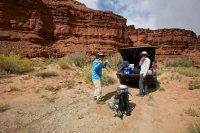
But even with the impressive skills of my expedition partners, this was sure to be no easy task. First we would spend many miles walking across the desert, fording mighty rivers and negotiating through the crumbling, jagged terrain.
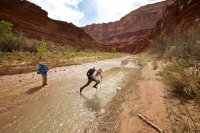
We didn't expect to see the cheemicowbra quite this soon on the trip but we still had to keep an eye out. There was sign of it's presence here in recent years.
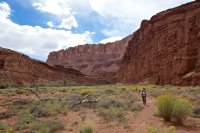
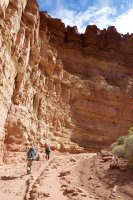
Soon we found ourselves crossing a high bench towards an area that I had previously seen the beast. The views were impressive but we couldn't let our guard down for a moment.
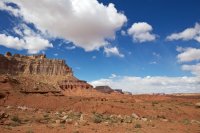
Along the way we came upon a homestead. We cautiously approached, hoping it's residents might be able to point us toward the elusive beast.
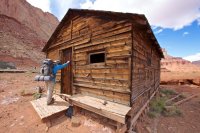
It quickly became clear that the cabin was not occupied.
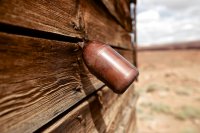
We let ourselves in to find relics from a time long ago. Clearly the cheemicowbra was to blame for this. Was it a mass exodus to escape the beast? Or worse perhaps. All we had to go off of was their belongings still left neatly on the shelves and tables. It was as if they just vanished. Our mission to find the cheemicowbra was now more important than ever.
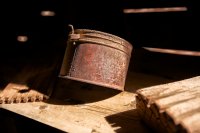
The cheemicowbra must have driven these people to drink...non-alcoholic beer. This was getting serious.
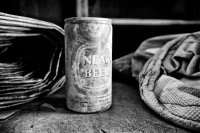
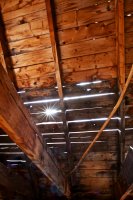
We left the cabin a bit shaken. None of us said it, but we were all thinking it. Has the cheemicowbra eaten all the grass and bushes and resorted to... PEOPLE?!? No. It couldn't be. It can't be. Keep hiking.
Soon we entered the canyon we suspected of being a cheemicowbra hideout. It was at this point on my previous visit that their sign was overpowering. But this time there was nothing. What was once a cheemicowbra mess of epic proportions, was now a pristine canyon. I would never have dreamed of filtering from this small spring before - now I would have almost drank it unfiltered.
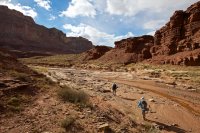
But we couldn't let our guard down just yet. This is a large canyon complex with many forks. The cheemicowbra could still be lurking in any of them.
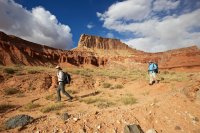
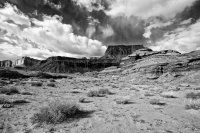
We walked high and low looking for sign but it was all old and petrified. All of the cheemicowbra trails that had plagued this area in the past were gone. The soil was stiff and easy to walk on. There was not a single foot print from man or cheemicowbra anywhere to be found.
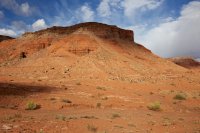
As we reached the junction of the upper forks, we encountered more signs of humans long gone. Once again, we wondered what role the cheemicowbra may have played.
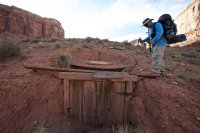
On my last expedition to this hostile environment, this section was a brutal sand slog. This time the wash surface was nearly solid and a joy to walk on. The absence of the cheemicowbra was notable and very much appreciated.
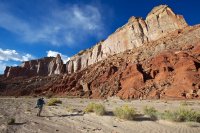
Another small, abandoned encampment. We searched high and low for evidence. Something to tell us we were on the right track. But all we found were relics.
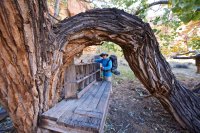
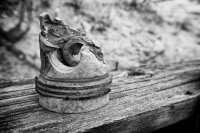
It was late in the day now and there was no sign of cheemicowbra. It was time to find a camp where we would be safe from the beast.
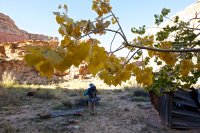
As we moved into another fork of the canyon, it was clear that it had been even longer since the cheemicowbra had been in this area. The landscape was pristine and a hint of fall kissed the cottonwoods.
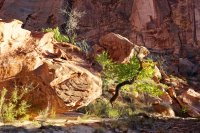
After setting up tents, we cleared a perimeter to make sure we wouldn't have any late-night run-ins with the cheemicowbra. You can never be too careful so Dan climbed up into a large cottonwood near our camp to get a better view.
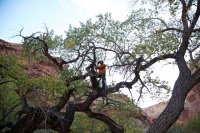
He didn't see any cheemicowbras but he did get a great vantage point for the beautiful sunset we witnessed from camp that evening.
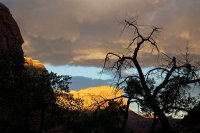
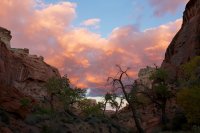
The next morning, feeling fairly confident that the cheemicowbra was not in the same fork of the canyon we were in, we traversed to another fork to take a look around.

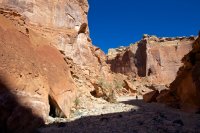
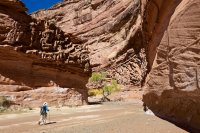
We walked and walked and found no sign at all. Just sand, rocks and a tree here and there.
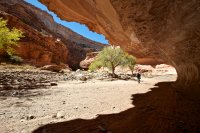
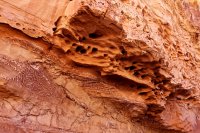
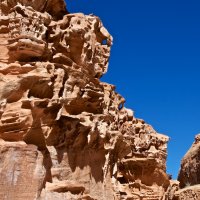
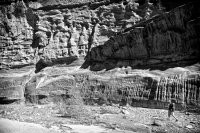
After exploring one fork, we moved onto the next. This fork had much more vegetation so we had to take our time to carefully explore each side canyon we came across. We found no sign of the cheemicowbra here either, but we did find some rather nice scenery.
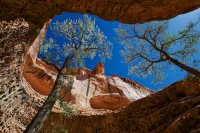
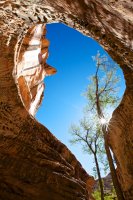
After exploring several side canyons of that fork, we eventually reached a dryfall. Well, mostly dry. It could have been bypassed by backtracking and doing a little 4th class scramble on the left LUC, but my knee was in no shape for it and there was no chance the cheemicowbra could have done it. We called this fork clear as well. Could it be the cheemicowbra is actually gone?
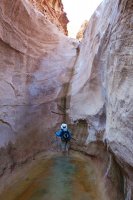
We headed back down and out of this fork and back to one last fork near our campsite before giving up for the day. The light in this 'musical' stretch of canyon was quite nice on the walk back out.
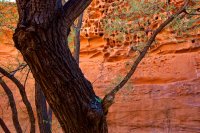
We were tired by the time we got to the next fork, but there was little light left and we were here for one reason - to find the cheemicowbra. We walked up this fork for 20 or 30 minutes and all we found was this large double (or maybe triple) arch. No cheemicowbra.
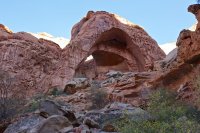
Feeling quite tired from all the searching, we retreated back to our campsite where the late evening sun was lighting up the cottonwoods.
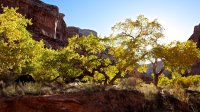
Nate was hesitant to give up the search, but it appeared for now, that the cheemicowbra had eluded us.
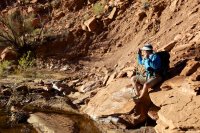
The next morning I had hoped to get up early and explore the last leg of the canyon we had yet to walk, but unfortunately time and energy did not allow it. We still had nearly a 10 mile walk to get out to the car, followed by 90 minutes of dirt roads just to get back to pavement. I'll come back though. And that damn cheemicowbra better hope it's not there when I do.
This was not my first time searching for the cheemicowbra. In fact, I have seen it on several occasions but I was overpowered by it's sheer mass. This time, I was determined to not let that happen so I reached out to some of the foremost experts in the field of cheemicowbraology to help me track the vile beast down - @Ndheiner and @slc_dan.

But even with the impressive skills of my expedition partners, this was sure to be no easy task. First we would spend many miles walking across the desert, fording mighty rivers and negotiating through the crumbling, jagged terrain.

We didn't expect to see the cheemicowbra quite this soon on the trip but we still had to keep an eye out. There was sign of it's presence here in recent years.


Soon we found ourselves crossing a high bench towards an area that I had previously seen the beast. The views were impressive but we couldn't let our guard down for a moment.

Along the way we came upon a homestead. We cautiously approached, hoping it's residents might be able to point us toward the elusive beast.

It quickly became clear that the cabin was not occupied.

We let ourselves in to find relics from a time long ago. Clearly the cheemicowbra was to blame for this. Was it a mass exodus to escape the beast? Or worse perhaps. All we had to go off of was their belongings still left neatly on the shelves and tables. It was as if they just vanished. Our mission to find the cheemicowbra was now more important than ever.

The cheemicowbra must have driven these people to drink...non-alcoholic beer. This was getting serious.


We left the cabin a bit shaken. None of us said it, but we were all thinking it. Has the cheemicowbra eaten all the grass and bushes and resorted to... PEOPLE?!? No. It couldn't be. It can't be. Keep hiking.
Soon we entered the canyon we suspected of being a cheemicowbra hideout. It was at this point on my previous visit that their sign was overpowering. But this time there was nothing. What was once a cheemicowbra mess of epic proportions, was now a pristine canyon. I would never have dreamed of filtering from this small spring before - now I would have almost drank it unfiltered.

But we couldn't let our guard down just yet. This is a large canyon complex with many forks. The cheemicowbra could still be lurking in any of them.


We walked high and low looking for sign but it was all old and petrified. All of the cheemicowbra trails that had plagued this area in the past were gone. The soil was stiff and easy to walk on. There was not a single foot print from man or cheemicowbra anywhere to be found.

As we reached the junction of the upper forks, we encountered more signs of humans long gone. Once again, we wondered what role the cheemicowbra may have played.

On my last expedition to this hostile environment, this section was a brutal sand slog. This time the wash surface was nearly solid and a joy to walk on. The absence of the cheemicowbra was notable and very much appreciated.

Another small, abandoned encampment. We searched high and low for evidence. Something to tell us we were on the right track. But all we found were relics.


It was late in the day now and there was no sign of cheemicowbra. It was time to find a camp where we would be safe from the beast.

As we moved into another fork of the canyon, it was clear that it had been even longer since the cheemicowbra had been in this area. The landscape was pristine and a hint of fall kissed the cottonwoods.

After setting up tents, we cleared a perimeter to make sure we wouldn't have any late-night run-ins with the cheemicowbra. You can never be too careful so Dan climbed up into a large cottonwood near our camp to get a better view.

He didn't see any cheemicowbras but he did get a great vantage point for the beautiful sunset we witnessed from camp that evening.


The next morning, feeling fairly confident that the cheemicowbra was not in the same fork of the canyon we were in, we traversed to another fork to take a look around.



We walked and walked and found no sign at all. Just sand, rocks and a tree here and there.




After exploring one fork, we moved onto the next. This fork had much more vegetation so we had to take our time to carefully explore each side canyon we came across. We found no sign of the cheemicowbra here either, but we did find some rather nice scenery.


After exploring several side canyons of that fork, we eventually reached a dryfall. Well, mostly dry. It could have been bypassed by backtracking and doing a little 4th class scramble on the left LUC, but my knee was in no shape for it and there was no chance the cheemicowbra could have done it. We called this fork clear as well. Could it be the cheemicowbra is actually gone?

We headed back down and out of this fork and back to one last fork near our campsite before giving up for the day. The light in this 'musical' stretch of canyon was quite nice on the walk back out.

We were tired by the time we got to the next fork, but there was little light left and we were here for one reason - to find the cheemicowbra. We walked up this fork for 20 or 30 minutes and all we found was this large double (or maybe triple) arch. No cheemicowbra.

Feeling quite tired from all the searching, we retreated back to our campsite where the late evening sun was lighting up the cottonwoods.

Nate was hesitant to give up the search, but it appeared for now, that the cheemicowbra had eluded us.

The next morning I had hoped to get up early and explore the last leg of the canyon we had yet to walk, but unfortunately time and energy did not allow it. We still had nearly a 10 mile walk to get out to the car, followed by 90 minutes of dirt roads just to get back to pavement. I'll come back though. And that damn cheemicowbra better hope it's not there when I do.
